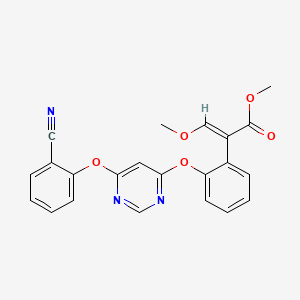D0541 | azoxystrobin
| Toxicity | Dose | Time | Species | Model | Method | Action | Positive criterion | Reference |
|---|---|---|---|---|---|---|---|---|
| ELECTRON TRANSPORT CHAIN | affect | 83 | ||||||
| ELECTRON TRANSPORT CHAIN | 100 mM | incubated overnight | bovine | isolated heart mitochondria | Measurements of redox potentials of the ISP | affect | 83 | |
| GLUCOSE GALACTOSE IC50 RATIO | 3.6 | LUHMES (Lund human mesencephalic) cells | Glc–Gal–NeuriTox assay | EC25(NA) [Glc/Gal] | 326 | |||
| Target | Dose | Time | Species | Model | Method | Action | Positive criterion | Reference |
|---|---|---|---|---|---|---|---|---|
| Quinol--cytochrome-c reductase | 3.6 | LUHMES (Lund human mesencephalic) cells | Glc–Gal–NeuriTox assay | EC25(NA) [Glc/Gal] | 326 | |||
| Qo site (Qp site or ubiquinol oxidation site) | mobile conformation | 83 | ||||||
| Qo site (Qp site or ubiquinol oxidation site) | 100 mM | incubated overnight | bovine | isolated heart mitochondria | Measurements of redox potentials of the ISP | fixed conformation | 83 | |
| Pictogram | Signal | Statements | Precautionary Statement Codes |
|---|---|---|---|
  |
Danger |
H331: Toxic if inhaled [Danger Acute toxicity, inhalation] H400: Very toxic to aquatic life [Warning Hazardous to the aquatic environment, acute hazard] H410: Very toxic to aquatic life with long lasting effects [Warning Hazardous to the aquatic environment, long-term hazard] |
P261, P271, P273, P304+P340, P311, P321, P391, P403+P233, P405, and P501; (The corresponding statement to each P-code can be found at the GHS Classification page.) |
  |
Danger |
Aggregated GHS information provided by 350 companies from 6 notifications to the ECHA C&L Inventory. Each notification may be associated with multiple companies. H331 (99.71%): Toxic if inhaled [Danger Acute toxicity, inhalation] H400 (90.57%): Very toxic to aquatic life [Warning Hazardous to the aquatic environment, acute hazard] H410 (100%): Very toxic to aquatic life with long lasting effects [Warning Hazardous to the aquatic environment, long-term hazard] Information may vary between notifications depending on impurities, additives, and other factors. The percentage value in parenthesis indicates the notified classification ratio from companies that provide hazard codes. Only hazard codes with percentage values above 10% are shown. |
P261, P271, P273, P304+P340, P311, P321, P391, P403+P233, P405, and P501; (The corresponding statement to each P-code can be found at the GHS Classification page.) |
  |
Danger |
H331: Toxic if inhaled [Danger Acute toxicity, inhalation] H410: Very toxic to aquatic life with long lasting effects [Warning Hazardous to the aquatic environment, long-term hazard] |
P261, P271, P273, P304+P340, P311, P321, P391, P403+P233, P405, and P501; (The corresponding statement to each P-code can be found at the GHS Classification page.) |
 |
Danger |
H331: Toxic if inhaled [Danger Acute toxicity, inhalation] |
P261, P271, P304+P340, P311, P321, P403+P233, P405, and P501; (The corresponding statement to each P-code can be found at the GHS Classification page.) |
| (E)-2-[2-[[6-(2-cyanophenoxy)-4-pyrimidinyl]oxy]phenyl]-3-methoxy-2-propenoic acid methyl ester | (E)-methyl 2-(2-(6-(2-cyanophenoxy)pyrimidin-4-yloxy)phenyl)-3-methoxyacrylate | (E)-methyl 2-[2-(6- (2-cyanophenoxy)pyrimidin-4-yloxy)phenyl]-3-methoxypropenoate |
| (E)-methyl 2-[2-(6-(2-cyanophenoxy)pyrimidin-4-yloxy)pheny]-3-methoxypropenoate | (E)-methyl 2-[2-(6-(2-cyanophenoxy)pyrimidin-4-yloxy)phenyl]-3-methoxypropenoate | (alphaE)-2-[[6-(2-cyanophenoxy)-4-pyrimidinyl]oxy]-alpha-(methoxymethylene) benzeneacetic acid methyl ester |
| 131860-33-8 | 1sqb | 215934-32-0 |
| 860A338 | A806322 | AB0016582 |
| AC-24498 | AKOS015900562 | Amistar |
| Azoxystrobin | Azoxystrobin 10 microg/mL in Cyclohexane | Azoxystrobin 100 microg/mL in Methanol |
| Azoxystrobin 1000 microg/mL in Methanol | Azoxystrobin [ISO] | Azoxystrobin, PESTANAL(R), analytical standard |
| Azoxystrobin, certified reference material, TraceCERT(R) | Azoxystrobine x | BEN380 |
| Bankit | Benzeneacetic acid, 2-((6-(2-cyanophenoxy)-4-pyrimidinyl)oxy)-alpha-(methoxymethylene)-, methyl ester, (E)- | Benzeneacetic acid, 2-((6-(2-cyanophenoxy)-4-pyrimidinyl)oxy)-alpha-(methoxymethylene)-, methyl ester, (alphaE)- |
| Benzeneacetic acid, 2-[[6-(2-cyanophenoxy)-4-pyrimidinyl]oxy]-alpha-(methoxymethylene)-, methyl ester, (alphaE)- | Benzeneacetic acid, 2-[[6-(2-cyanophenoxy)-4-pyrimidinyl]oxy]-|A-(methoxymethylene)-, methyl ester, (|AE)-; | C-21771 |
| C18558 | C22H17N3O5 | CAS-131860-33-8 |
| CHEBI:40909 | CHEMBL230001 | DB07401 |
| DNDI1511705 | DSSTox_CID_12520 | DSSTox_GSID_32520 |
| DSSTox_RID_78966 | DTXSID0032520 | EINECS Annex I Index 607-256-00-X |
| HSDB 7017 | Heritage | ICI-A 5504 |
| Icia 5504 | Icia-5504 | J-006072 |
| J-519625 | J90052 | K-4132 |
| KS-5365 | LS-28710 | METHYL (2Z)-2-(2-{[6-(2-CYANOPHENOXY)PYRIMIDIN-4-YL]OXY}PHENYL)-3-METHOXYACRYLATE |
| Methyl (2E)-2-(2-{[6-(2-cyanophenoxy)-4-pyrimidinyl]oxy}phenyl)-3-methoxyacrylate | Methyl (E)-2-(2-(6-(2-cyanopheoxy)pyrimidin-4-yloxy)phenyl)-3-methoxypropenoate | NCGC00163818-01 |
| NCGC00163818-02 | NCGC00163818-03 | NCGC00163818-04 |
| NCGC00163818-05 | NYH7Y08IPM | O662 |
| Q2013860 | Quadris | SC-24628 |
| SCHEMBL18823 | SCHEMBL55087 | TCMDC-125883 |
| Tox21_400087 | UNII-NYH7Y08IPM | WFDXOXNFNRHQEC-GHRIWEEISA-N |
| ZINC13827839 | methyl (2E)-2-(2-{[6-(2-cyanophenoxy)pyrimidin-4-yl]oxy}phenyl)-3-methoxyacrylate | methyl (2E)-2-(2-{[6-(2-cyanophenoxy)pyrimidin-4-yl]oxy}phenyl)-3-methoxyprop-2-enoate |
| methyl (E)-2-[2-[6-(2-cyanophenoxy)pyrimidin-4-yl]oxyphenyl]-3-methoxy-prop-2-enoate | methyl (E)-2-[2-[6-(2-cyanophenoxy)pyrimidin-4-yl]oxyphenyl]-3-methoxyprop-2-enoate | methyl (E)-2-[2-[6-(2-cyanophenoxy)pyrimidin-4-yloxy]phenyl]-3-methoxyacrylate |
| methyl (E)-2-{2-[6-(2-cyano-phenoxy)pyrimidin-4-yloxy]phenyl}-3-methoxyacrylate | methyl (E)-2-{2-[6-(2-cyanophenoxy)pyrimidin-4-yloxy]phenyl}-3-methoxyacrylate |

